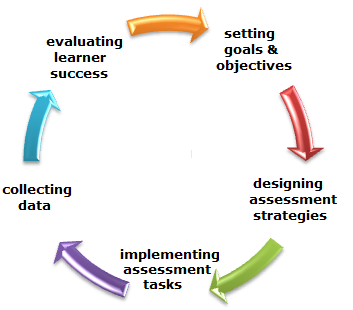Assessment and Evaluation
 Assessing and evaluating student knowledge, skills, and attitudes can be a difficult task in a traditional classroom. It has added challenges in a system in which the teacher is physically separated from the student. In a digital learning environment, the process requires more authentic approaches to assessment. These also provide students with opportunities to demonstrate their learning in a more personal way to their teacher. Authentic assessment strategies can help build deeper relationships and deeper knowledge of learner abilities from a distance.
Assessing and evaluating student knowledge, skills, and attitudes can be a difficult task in a traditional classroom. It has added challenges in a system in which the teacher is physically separated from the student. In a digital learning environment, the process requires more authentic approaches to assessment. These also provide students with opportunities to demonstrate their learning in a more personal way to their teacher. Authentic assessment strategies can help build deeper relationships and deeper knowledge of learner abilities from a distance.
Student assessment and evaluation is a cycle, from setting goals through designing and implementing assessment strategies, to collecting data and evaluating learner success.
From the data collected from digital learning tools, the teacher can determine which areas of instruction may need to be revamped and which have worked well for most, if not all students.

Premade digital learning courses are often static. Evaluating and changing a course can be time consuming and difficult. Whenever possible, include other elements that invite student participation and discussion, that can be tweaked as the needs of students evolve.
Authentic assessment is a learner-centered approach. The assessment tasks have real-world application and usually have criteria attached. Performance assessment and direct assessment are terms also used to describe authentic assessment.
Authentic Assessment Approach
Authentic assessment describes an approach in which:
- Evaluation is ongoing.
- Feedback on learner success is frequently communicated.
- The learner is a central element in the process.
- The purpose is for learner improvement.
- The learner has a vested interest in the outcome of the process.
- The learner performs real world tasks to demonstrate application of knowledge, skills, and attitudes.
- The process is valued as well as the product.
- Learner application of the knowledge, skills, and attitudes demonstrates understanding.
- A variety of assessment methods are utilized (e.g., tests, demonstrations, performances).
These include regular reviews of student performance, digital and/or telephone conversations, and observations that rely more on how a student’s work or participation has changed over time. Teachers can use traditional classroom approaches, modified for the digital environment. Digital portfolios replace accumulations of work done on paper, oral presentations are replaced by written submissions, displays of student work become compilations of file uploads, and self-evaluations occur during digital or telephone conversations with the teacher.
The authentic assessment approach creates greater opportunities for students to show what they know in a variety of ways. Access via the Internet increases the number and types of these opportunities.
Some considerations in a digital learning environment that every teacher must take into account include:
- Academic honesty—the teacher needs to know that the work being presented has actually been done by the student and not someone else. Parental involvement is an important tool in assuring this.
- Appropriate goals—the goal setting activities used in each course should allow each student to have some input. This informs the teacher about how the student sees themself as a learner, and views their own capabilities and commitment.
- Opportunities for interaction—even if students are taking the course at their own pace, provide opportunities for interaction such as posting individual commitments about what they are going to complete each week. Ask for reflection on how they did in reaching their weekly goal.
- Manageable assignments—if assignments are complex, or have multiple parts, break these down into smaller components so the teacher can assess students at several points during the learning process. Provide detailed and explicit rubrics whenever it is necessary to ensure expectations are fully understood.
- Use of formative assessments—formative assessment is even more important in digital learning because the teacher must monitor the student’s development and provide them with timely feedback to assist their progress toward achieving their goals. Summative assessments are more likely to be misinterpreted and run a higher risk of discouraging students.
- Leave summative assessment to the end—summative assessment, for the reason stated above, should occur at the end of the learning process. Written assignments, online discussion, the use of visual tools such as concept maps, and synchronous conferencing tools provide better opportunities to motivate students. While short quizzes or multiple-choice questions can be used during the course, a more traditionally designed test is best left to the end, with the opportunity for review with the student and a second make-up test if necessary, whenever possible (Kearns, 2012).
The framework for authentic assessment begins with the same question that should be used when designing curriculum, “What should students be able to do?” For teachers assessing work in a digital learning environment, the question remains the same, but the tools used to determine how each student has progressed toward mastery must include frequent check-ins and attention to individual progress on an ongoing basis.